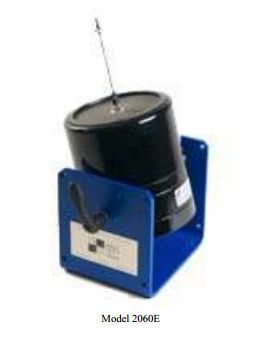
Shaker Model 2060E
Modal Exciter 60 lbf
Model 2060E
When performing experimental modal analysis, the choice of excitation function and system can make the difference between a good measurement and a poor one. For many modal test applications, an electrodynamic shaker system is best suited for creating an appropriate input forcing function. Distributing adequate input force energy across the test structure and obtaining accurate and reliable input force measurements is critical for successful modal and structural testing. This often requires a shaker that is highly portable, rugged and easy to setup in order to facilitate the best exciter location (relative to the test structure) while minimizing any unwanted interaction between the exciter and test structure.
The Modal Shop 2060E, a lightweight electrodynamic modal exciter, is capable of providing up to 60 lbf (267 N) of peak force excitation in a small footprint weighing just 37 pounds (17 kg). With an extended 1.4" (36mm) stroke and frequency range up to 6 kHz, the 2060E is suitable for structural testing and experimental modal analysis applications, including single and multiple inputs (SIMO and MIMO) using random, burst random, sine dwell or chirp excitation signals.
Benefits:
- Through-hole armature with chuck and collet attachment provides simple setup with modal stingers.
- Lightweight and portable – weighing just 37 lbs (17 kg).
- Trunnion base provides flexibility and ease set up when aligning the shaker and choosing best exciter location(s).
- 1.4” extended stroke and broad 6 KHz frequency range supply adequate input energy for almost any modal test applications.
- Forced air cooling sufficient to meet full shaker performance (60 lbf pk) specifications.
All of the Modal Shop modal shakers are supplied in a trunnion base allowing full rotation for easy setup. The through-hole armature design with chuck and collet attachment is ideal for use with either traditional modal stinger rods, like the TMS 2150G12 1/16” diameter stingers, or piano wire stingers, like the TMS K2160G piano wire stinger kit with force sensor quick disconnect. These stingers greatly simplify test setup with an easy connection to the force sensor and test structure, and help decouple cross-axis force inputs, minimizing or eliminating input force measurement errors while using the modal shaker. For horizontal force inputs, the modal shakers adapt directly to The Modal Shop’s 2050A lateral excitation shaker stand. Using four turnbuckles, the modal shaker is supported by its trunnion base and can be adjusted over a wide horizontal and vertical area relative to the test structure.